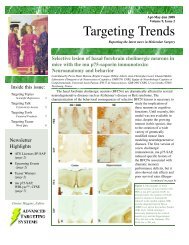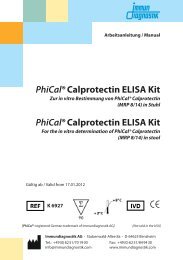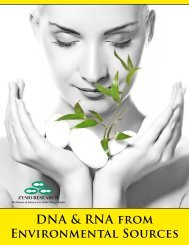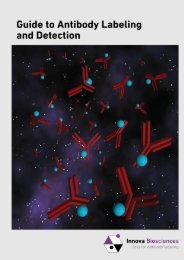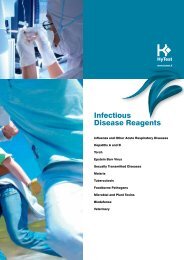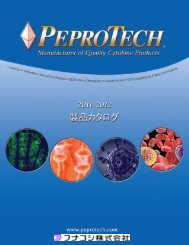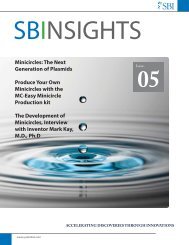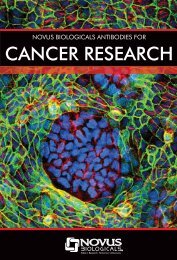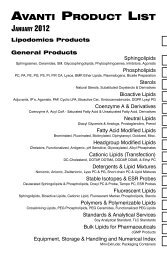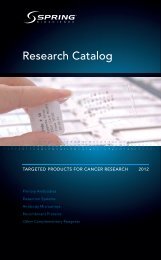Thermo Scientific Pierce Crosslinking Technical Handbook
Thermo Scientific Pierce Crosslinking Technical Handbook
Thermo Scientific Pierce Crosslinking Technical Handbook
You also want an ePaper? Increase the reach of your titles
YUMPU automatically turns print PDFs into web optimized ePapers that Google loves.
Appendix III – Glossary of <strong>Crosslinking</strong> Terms<br />
Acylation: Reaction that introduces an acyl group (-COR) into<br />
a compound.<br />
Aryl azide: Compound containing a photoreactive functional group<br />
(e.g., phenyl azide) that reacts nonspecifically with target molecules.<br />
Carbodiimide: Reagent that catalyzes the formation of an amide<br />
linkage between a carboxyl (–COOH) group and a primary amine<br />
(–NH 2 ) or a hydrazide (–NHNH 2 ). These reagents do not result<br />
in the formation of a cross-bridge and have been termed<br />
zerolength crosslinkers.<br />
Crosslinker: A reagent that will react with functional groups<br />
on two or more molecules to form a covalent linkage between<br />
the molecules.<br />
Conjugation reagent: A crosslinker or other reagent for covalently<br />
linking two molecules.<br />
Diazirine crosslinker: The succinimidyl-ester diazirine (SDA)<br />
crosslinkers combine amine-reactive chemistry with an efficient<br />
diazirine-based photochemistry for photo-crosslinking to nearly<br />
any other functional group. The photoactivation of diazirine with<br />
long wave UV light (330-370 nm) creates carbene intermediates.<br />
These intermediates can form covalent bonds via addition<br />
reactions with any amino acid side chain or peptide backbone<br />
at distances corresponding to the spacer arm lengths.<br />
Disulfide bonds: Oxidized form of sulfhydryls (- S–S -); formed in<br />
proteins through –SH groups from two cysteine molecules. These<br />
bonds often link polypeptide chains together within the protein<br />
and contribute to a protein’s tertiary structure.<br />
α-Haloacyl: Functional group (e.g., iodoacetyl) that targets<br />
nucleophiles, especially thiols. α-Haloacyl compounds have a<br />
halogen atom such as iodine, chlorine or bromine attached to an<br />
acyl group on the molecule. These alkylating reagents degrade<br />
when exposed to direct light or reducing agents, resulting in the<br />
loss of the halogen and the appearance of a characteristic color.<br />
Hapten: A molecule recognized by antibodies but unable to elicit<br />
an immune response unless attached to a carrier protein. Haptens<br />
are usually, but not always, small (< 5 kDa) molecules.<br />
Homobifunctional crosslinker: Reagent with two identical reactive<br />
groups used to link two molecules or moieties.<br />
Heterobifunctional crosslinker: Reagent with two different<br />
reactive groups used to link two molecules or moieties.<br />
Hydrophilic: Substances that readily dissolve in water.<br />
Hydrophobic: Substances with limited solubility in water.<br />
N-Hydroxysuccinimidyl (NHS) ester: Acylating reagents commonly<br />
used for crosslinking or modifying proteins. They are specific for<br />
primary (–NH 2 ) amines between pH 7-9, but are generally the most<br />
effective at neutral pH. These esters are subject to hydrolysis, with<br />
half-lives approximating one to two hours at room temperature at<br />
neutral pH.<br />
Imidate crosslinker: Primary amine-reactive functional group<br />
that forms an amidine bond. The ε-amine in lysine and N-terminal<br />
amines are the targets in proteins. Imidates react with amines in<br />
alkaline pH conditions (pH range 7.5-10) and hydrolyze quickly,<br />
with half-lives typically around 10-15 minutes at room temperature<br />
and pH 7-9. At pH > 11, the amidine bond is unstable, and crosslinking<br />
can be reversed. The amidine bond is protonated at<br />
physiological pH; therefore, it carries a positive charge.<br />
Imidoester: Amine-reactive functional group of an<br />
imidate crosslinker.<br />
Immunogen: A substance capable of eliciting an immune<br />
response.<br />
Integral membrane protein: Protein that extends through the cell<br />
membrane and is stabilized by hydrophobic interactions within the<br />
lipid bilayer of the membrane.<br />
Ligand: A molecule that binds specifically to another molecule.<br />
For example, a protein that binds to a receptor.<br />
Moiety: An indefinite part of a sample or molecule.<br />
Monomer: Consisting of a single unit.<br />
NHS: Abbreviation for N-hydroxysuccinimide.<br />
Nitrene: Triple-bonded nitrogen-to-nitrogen reactive group formed<br />
after exposure of an azido group to UV light. Its reactivity is nonspecific<br />
and short-lived.<br />
Nonselective crosslinking: <strong>Crosslinking</strong> using a reactive group,<br />
such as nitrenes or aryl azides, which react so quickly and broadly<br />
that specific groups are not easily and efficiently targeted. Yields<br />
are generally low with many different crosslinked products formed.<br />
Nonspecific crosslinking: Another term for nonselective crosslinking.<br />
Oligomer: A molecule composed of several monomers.<br />
Photoreactive: A functional group that becomes reactive upon<br />
excitation with light at a particular range of wavelengths.<br />
Polymer: A molecule composed of many repeating monomers.<br />
Pyridyl disulfide: Aromatic moiety with a disulfide attached to<br />
one of the carbons adjacent to the nitrogen in a pyridine ring.<br />
Pyridine 2-thione is released when this reagent reacts with a<br />
sulfhydryl (–SH)-containing compound.<br />
Spacer arm: The part of a crosslinker that is incorporated<br />
between two crosslinked molecules and serves as a bridge<br />
between the molecules.<br />
Substrate: A substance upon which an enzyme acts.<br />
Sulfhydryl: –SH groups present on cysteine residues in proteins.<br />
Thiols: Also known as mercaptens, thiolanes, sulfhydryls or<br />
–SH groups, these are good nucleophiles that may be targeted<br />
for crosslinking.<br />
Ultraviolet: Electromagnetic radiation of wavelengths<br />
between 10-390 nm.<br />
To order, call 800-874-3723 or 815-968-0747. Outside the United States, contact your local branch office or distributor.<br />
45



